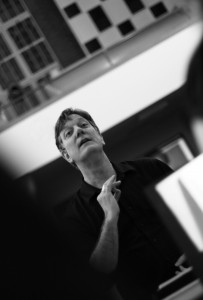Vespers Music by Monteverdi and Cavalli for the Feast of St. Mark
Artistic Director Warren Stewart will lead Magnificat and the Whole Noyse in the concluding concert of the 2014 Berkeley Festival and Exhibition on Sunday June 8, 4:00 p.m. at Berkley’s First Congregational Church. The program will feature music from Claudio Monteverdi’s Selva morale e spirituale (1641) and Francesco Cavalli’s Musiche sacre (1656.) Tickets are available through www.berkeleyfestival.org.
 In the last decade of his life Claudio Monteverdi assembled two monumental collections of music that form a testament to his thirty-year tenure in Venice. His Eighth Book of Madrigals – those of War and Love – was published in 1636 while his omnibus collection of sacred music Selva morale e spirituale (Sacred and spiritual forest) – the source for most of the music on our program – appeared in 1641. The madrigal book was dedicated to the Hapsburg Emperor Ferdinand III while Selva morale was dedicated to Ferdinand’s stepmother, the dowager Empress Eleonora Gonzaga, daughter of Duke Vincenzo Gonzaga of Mantua and widow of the Hapsburg Emperor Ferdinand II.
In the last decade of his life Claudio Monteverdi assembled two monumental collections of music that form a testament to his thirty-year tenure in Venice. His Eighth Book of Madrigals – those of War and Love – was published in 1636 while his omnibus collection of sacred music Selva morale e spirituale (Sacred and spiritual forest) – the source for most of the music on our program – appeared in 1641. The madrigal book was dedicated to the Hapsburg Emperor Ferdinand III while Selva morale was dedicated to Ferdinand’s stepmother, the dowager Empress Eleonora Gonzaga, daughter of Duke Vincenzo Gonzaga of Mantua and widow of the Hapsburg Emperor Ferdinand II.
The publication of such retrospective collections was customary among prestigious musicians at San Marco, with examples from Willaert’s Musica Nova, to the Gabrielis’ Symphoniæ Sacræ to the other source of music on our program, Cavalli’s Musiche sacre. Though some twenty sacred works by Monteverdi appeared in various anthologies during the 1620s and 30s, Selva morale is the only volume devoted to his Venetian sacred music that was published during his lifetime and under his supervision, and while it contains a substantial body of work, it nonetheless represents only a fraction of the sacred music he must have composed as maestro at San Marco.
Like the Eighth Book of Madrigals, Selva morale is divided into two sections. The first opens with a sequence of spiritual madrigals and arias, each dealing with the transitory nature of human life and worldly success. A four-voice stile antico setting of the Mass ordinary together with a concerted Gloria and three sections of the Credo follow these madrigals, with a solo bass aria completing the first part. The second part contains psalms, hymns and Magnificats for Vespers, a series of Marian antiphons, two non-liturgical texts, and a sacred contrafacta of the famous Lament of Arianna. Unlike Monteverdi’s celebrated Vespers of 1610, which contains only a single sequence of psalms, hymn and Magnificat for feasts of the Blessed Virgin, Selva morale includes multiple settings of individual texts from which a choirmaster could select those proper for a particular feast. Our program this evening follows the liturgy for the First Vespers of Saint Mark, the patron saint of Venice, and the psalms, antiphons, chapter and hymn have been chosen accordingly.
The large-scale settings on our program (Dixit Dominus, Beatus vir, Laudate Dominum and the Magnificat) are written in the concertato style in which structure and variety are achieved by means of often dramatically contrasting textures with massive tutti sections alternating with duets and trios and dialogues between pairs of singers and pairs of instruments. Indeed, contrasts as a means of expressing rhetoric and emotion permeate the entire collection and call to mind Monteverdi’s observation in the preface of the Eight Book of Madrigals “that it is contraries which deeply affect our mind, the goal of the effect that good music ought to have.”
The other two psalms on the program are for five voices. Confitebor tibi terzo is designated “alla francese” (in the French manner), a compositional style that Monteverdi’s brother Giulio Cesare maintained was introduced into Italy by Monteverdi. The precise meaning of the term is uncertain, perhaps indicating a tuneful, full-voiced singing style associated with northern Europe or, like some of Monteverdi’s other “French” works, it may refer to a call and response style and the frequent paired setting of syllables. With its free alteration of the psalm text, the first of the settings of Laudate pueri, as well as the Magnificat primo, represents a style fashionable in the 1640s described by one contemporary writer as ‘salmi bizarri,’ or ‘clever psalms.’ Its melodic material is focused on two contrasting subjects – a duple meter tenor duet that acts as a ritornello and an aria-like triple meter section that evolves over the course of the psalm.
Monteverdi provided several hymn settings and indicated that each could be used for other hymns in the same meter. The hymn for Feasts of Apostles and Evangelists, Tristes erant Apostoli, fits the meter of Monteverdi’s second setting of Deus tuorum militum, for alto, tenor, bass, violins and continuo. For his hymns, Monteverdi sets the pre-Tridentine versions of hymns from the Common of Saints, texts which continued to be used at San Marco even after Pope Urban VII’s reforms of 1632.
The dialogue motet Iubilet tota civitas is curiously designated “a voce solo in Dialogo”, and in the partbook the single melody contains rubrics instructing canta (sing) or tacet (be silent). Most likely the motet was intended for two equal voices, one calling upon the city to rejoice and the other asking about the occasion for rejoicing. The saint’s name is given simply as ‘sanctus N.’, making this a general purpose motet into which any saint’s name can be inserted as required – for our program Saint Mark.